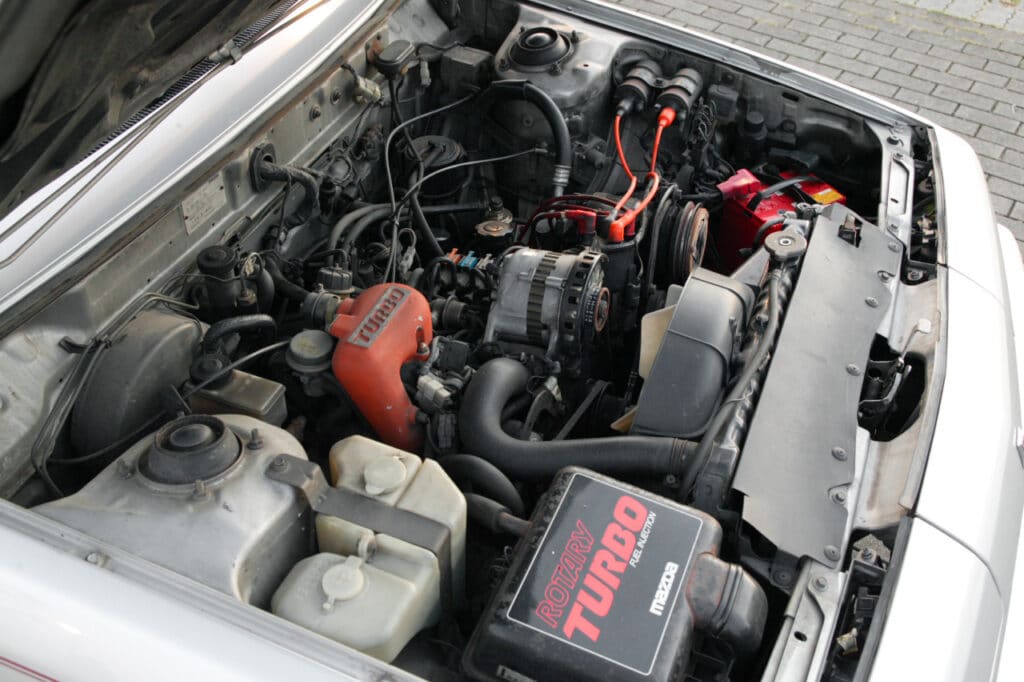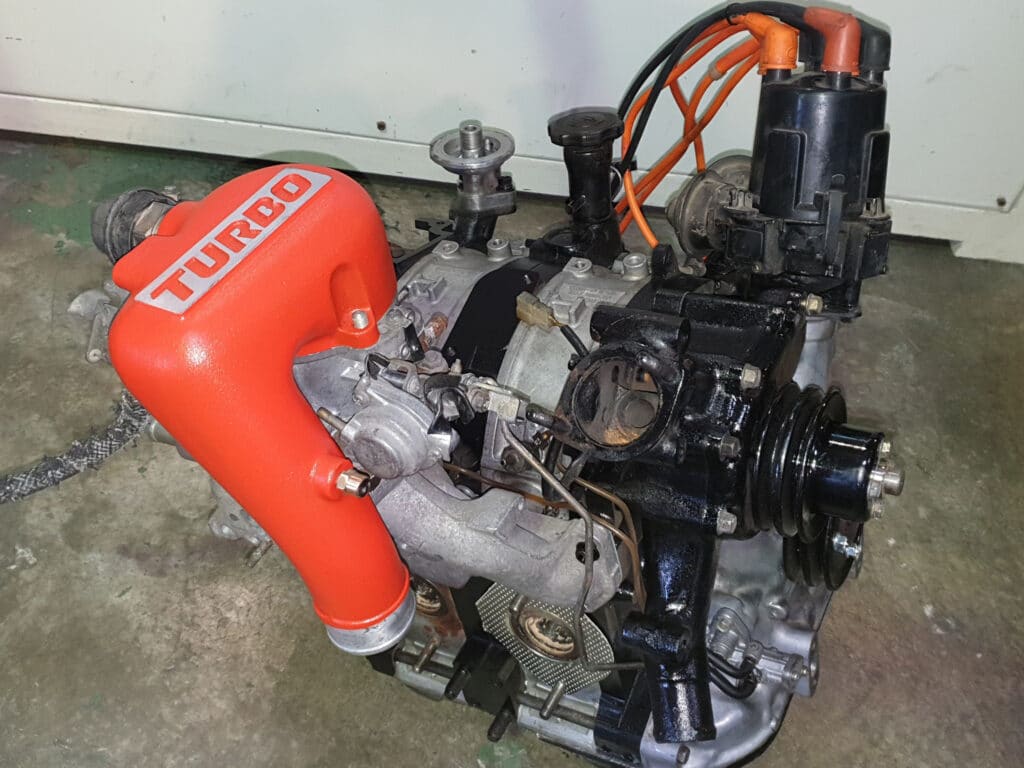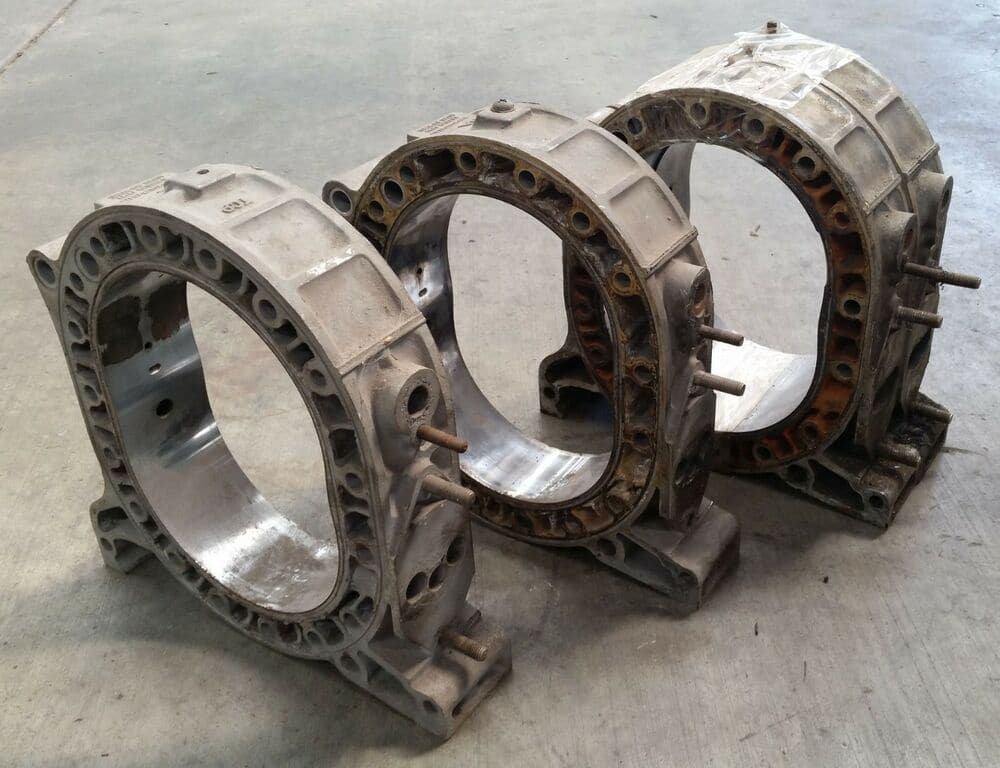The 12A engine is essentially a larger version of the 10A — Mazda’s first-ever mass-produced rotary engine. Available in naturally aspirated and turbocharged variants, the 12a engine powered cars such as Mazda’s R100, RX-2, RX-3 (Japan), RX-4, Luce, and most notably the Gen 1 RX-7.
The naturally aspirated 12A was carbureted while the turbo variant got electronic fuel injection. Sadly, the latter was never sold in the North American market.
Just like the 10A engine, it featured a two-rotor design but with larger displacement. The increased depth from 10 mm to 70 mm means it can displace 573 cc in each chamber. So two chambers put together displace 1146 cc.
The 12A engine saw an impressive 15-year production run from May 1970 to 1985. Quite impressive for a rotary. It was the first engine built outside of western Europe and the U.S. to finish the 24 hours of Le Mans.
In this guide, we’ll take a closer look at the 12A engine by briefly discussing its specs, reliability, and various porting options. Let’s dive right in!
Mazda 12A Engine Specs

Manufacturer: Mazda
Production Years: 1970-1985
Engine Code: 12A
Configuration: Dual-rotor, Wankle (rotary engine)
Displacement: 1146 cc
Fuel System: Carbureted (turbo variant got electronic fuel injection)
Cylinder Block Material: Aluminum
Compression Ratio: 9.4:1 (turbo variant — 8.5:1)
Power: 100-130 hp @7000 rpm
Torque: 100-115 lb-ft @3500 rpm
Engine Weight: 384 lbs (dry)
Engine Oil Weight: 20W-50
Engine Oil Capacity: 4.2 liters
Oil Change Interval: 7,500 miles
The 12A is incredibly light, tiny, loves to rev high, and can make a ton of power when modified properly. However, they’re extremely thirsty, barely make any torque, need a lot of babysitting, and frequent rebuilds.
Despite the outlandish nature and non-feasibility of the rotary platform, Mazda consistently updated it, making it better, stronger, and more powerful in small increments.
For the 12A engine, In 1974, they used a new process called “sheet-metal-insert” to harden and reinforce the rotor housing. This process used a sheet of steel much like a regular piston-engine cylinder liner with a chrome-plated surface. The material selection for this engine is just as quirky as the engine itself.
The rotor housing is aluminum, rotors are cast iron, the eccentric shafts are made of chrome-molybdenum steel, and the ever-important apex seals utilize a combination of aluminum and carbon steel.
Early examples of the 12A engine feature a thermal reactor, similar to the one on the 10A. Some utilize an exhaust port insert to reduce drone and overall exhaust noise. Arguably, the most significant modification of the 12A architecture was the 6PI (6-port) which featured variable induction ports. However, this was a JDM exclusive feature and rare in other markets.
12A Turbo

Mazda produced a turbocharged version of the 12A engine which was used in the Cosmo, Luce, and the SA series RX-7. The most significant improvement in this engine was the inclusion of electronically controlled fuel injection. Semi-direct, simultaneous injection into both rotors, to be specific.
The engine also received a passive knock sensor as a part of the much-required knock-prevention system. This was the very first production, turbocharged, and electronically fuel-injected rotary engine in history.
Turbine duties are carried out by a Hitachi HT18-BM turbocharger. Compared to the naturally aspirated version of the 12A, the turbocharged version has a lower compression ratio of 8.5:1. It produces 120 hp @6500 rpm and 197 lb-ft at 4000 rpm.
The later models of the 12A turbo were equipped with the smaller and lighter Hitachi HT18S-BM turbo featuring a smaller 57 mm turbine and a 56 mm compressor. This pushed the power output to 165 hp @6000 rpm and 170 lb-ft at 4000 rpm.
12A Reliability
Preventative maintenance is a huge deal with rotarys. You need to check your oil level pretty much daily, along with performing a battery of other rotary-specific rituals to prevent damage. But that’s the beauty of this platform — it’s ideal for hobbyists and purists.

Rotary engines are oil guzzlers, thanks to the onboard oil metering pump (OMP). Its job is to draw oil from the lubrication system and spray it directly onto the apex seals through specialized oil injectors.
The worst thing that you can do is not monitor your oil levels and let it go thirsty. Because if your 12A is burning oil (which it inevitably will), it’s going to leave a ton of soot and residue which will lead to your apex seals getting worn out prematurely.

This issue can be remedied by getting rid of the stock OMP and using 2-stroke oil as a premix in your gas tank. This is highly recommended if your 12A is bridge ported or peripheral ported.
It’s worth mentioning that naturally aspirated 12A engines are much more reliable than their turbo variants. If you’re lucky and follow the preventative maintenance routine religiously, your NA 12A won’t need a rebuild before 150,000 miles.
12A Porting Options
Porting is one of the most reliable ways to get more power out of your rotary engine. Significantly more reliable than forced induction.
If you’ve researched the subject of modifying rotary engines, chances are that you must’ve come across terms such as “street porting”, “bridge porting”, and “peripheral porting”.
Essentially, these methods follow the same principle as porting the cylinder heads on a piston engine. The objective is to improve airflow in and out of the combustion chambers.
With rotary engines, however, it’s done differently. In these engines, porting can have a very similar effect to installing high-lift cams in a piston engine.
That’s because you’re essentially changing the parameters that decide how early and how long the air charge is allowed into and out of the combustion chambers. This is done by reshaping the opening and closing ports with a die grinder.
This is obviously an oversimplification, but we’ll leave the details for another article.
Here’s a summary of different porting options for 12A engines:
- Bridge port: Involves cutting an eyebrow above the intake port, allowing the intake charge to enter the chamber earlier.
- Street Port: Involves increasing the port stock size to bring in the fuel-air mixture earlier.
- Extended Port: Involves pulling the openings even further wide, causing overlap.
- Peripheral Port: The ultimate form of rotary porting. Involves getting rid of the ports on the iron and instead of creating completely new ports on the housings, allowing for a massive amount of overlap and peak performance
You’re quite unlikely to see peripheral ported rotarys in road cars. Street porting and bridge porting are more common, however.
Concluding Thoughts
Rotary engines hold a special place in the automotive community. Owning and getting the most out of it requires serious commitment and dedication.
Besides that, you’ll also need some mechanical skills under your belt, along with all the right tools and equipment.
If your mind is set on owning a rotary, the 12A is a great platform to start with. Love learning about Mazda engines? Check out this guide to Mazda’s 20B 3-rotor engine. What’s your favorite Wankle engine? Let us know by leaving a comment below!
I'm an automotive enthusiast with a deep understanding of rotary engines, particularly the Mazda 12A engine. My knowledge is not merely theoretical; I've delved into the intricate details of rotary technology and have hands-on experience with various rotary engines, making me well-versed in their specifications, modifications, and performance characteristics.
The Mazda 12A engine, introduced as an evolution of the 10A, is a dual-rotor Wankel engine that powered iconic Mazda vehicles such as the R100, RX-2, RX-3, RX-4, Luce, and the first-generation RX-7. Its production spanned an impressive 15 years, from 1970 to 1985, showcasing Mazda's commitment to refining and advancing rotary technology.
Let's break down the key concepts mentioned in the article:
1. Engine Specifications:
- Manufacturer: Mazda
- Production Years: 1970-1985
- Engine Code: 12A
- Configuration: Dual-rotor, Wankel (rotary engine)
- Displacement: 1146 cc
- Fuel System: Carbureted (turbo variant with electronic fuel injection)
- Cylinder Block Material: Aluminum
- Compression Ratio: 9.4:1 (turbo variant — 8.5:1)
- Power: 100-130 hp @7000 rpm
- Torque: 100-115 lb-ft @3500 rpm
- Engine Weight: 384 lbs (dry)
- Engine Oil Weight: 20W-50
- Engine Oil Capacity: 4.2 liters
- Oil Change Interval: 7,500 miles
2. 12A Turbo:
- Turbocharged version used in the Cosmo, Luce, and SA series RX-7
- Electronically controlled fuel injection
- Hitachi HT18-BM turbocharger
- Lower compression ratio (8.5:1)
- Power output: 120 hp @6500 rpm (early models), 165 hp @6000 rpm (later models)
3. Engine Materials and Modifications:
- "Sheet-metal-insert" process in 1974 to harden and reinforce the rotor housing
- Materials: Aluminum rotor housing, cast iron rotors, chrome-molybdenum steel eccentric shafts, aluminum and carbon steel apex seals
- Thermal reactor and exhaust port insert in early models
- 6PI (6-port) architecture with variable induction ports (JDM exclusive)
4. Reliability:
- Rotary engines require meticulous preventative maintenance
- Oil guzzlers due to the onboard oil metering pump (OMP)
- Importance of monitoring oil levels to prevent premature wear of apex seals
- Naturally aspirated 12A engines are more reliable than turbo variants
5. Porting Options:
- Porting as a reliable way to increase power in rotary engines
- Types: Bridge port, Street port, Extended port, Peripheral port
- Effects similar to modifying cylinder heads in piston engines
- Street porting and bridge porting are more common than peripheral porting
In conclusion, the Mazda 12A engine is a lightweight, high-revving powerplant with a rich history and a unique place in the automotive world. Understanding its specifications, reliability considerations, and porting options is crucial for enthusiasts looking to maximize its potential.